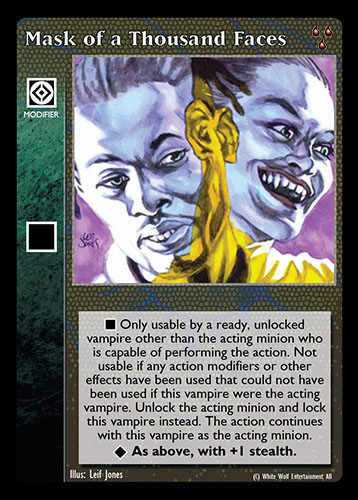
Words by Vincent Ripoll, rules director of Black Chantry Productions:
It has been 30 years of Vampire: The Eternal Struggle (VTES), and we want to dwell a bit on how the rules of the game have changed in this time. A good way to look at this is by the “eras” of the three main contributors:
L. Scott Johnson (“LSJ”) played a pivotal role in establishing the rules of VTES as we know them today through various rulings and errata. His work spanned from 1998 to the end of the White Wolf era in 2010, starting with collecting answers from the official net.rep of Wizard of the Coast at that time as well as house rules, then becoming the official net.rep himself and releasing the quite legendary RTR 7-7 which paved the way for the game we know today.
Pascal Bertrand contributed greatly to the rules between 2010 and 2016, especially focusing on naming concepts and fixing typos. His rulings defined the finer aspects of card interactions, such as the “impulse” as well as redefining official formats for tournaments when the game was no longer published. His clarifications greatly influenced the official VTES rulings, helping streamline game design and card effects.
Vincent Ripoll’s rule changes, particularly from 2018 onward, focused on consistency in the wording, defining some of the most technical parts in a logical way, as well as simplifying or making certain mechanics more intuitive.
Changes by L. Scott Johnson
Back in 1998, VTES rules were a mess. It was the early days of CCG, and although the game mechanics were sound, many interactions were ill-defined, and many cards were not clear enough or consistent enough. There were a lot of house rules back then, because it was much harder for players to find information about games. The Internet was very different, and players had only USENET servers to communicate, so messages could be easily lost based on their retention policy.
LSJ “started with a small dusting of corner-tidying cases” (such as restricting the duration of combat effects to the round – Immortal Grapple used to last the whole combat) before releasing one of the first “Rule Team Rulings”, but undoubtedly the most influential: the 7-7 RTR. It defined what (D) actions were (before that, you could have (D) actions directed at yourself that no one could block), limiting vote cards one could discard during a vote, the way aggravated damage worked, but also errata such as Fame’s current card text. It also included some changes that would later on be reversed (such as not being able to play combat cards after a combat ends). The third RTR that year gave the general targeting rule (basically: targets must be appropriate) that would lead to “you cannot attempt what you cannot do”.
In 1999, most changes were card errata (such as the first errata on the VTES version of Parity Shift that allowed you to reallocate the pool after the referendum passed) or bans (Return to Innocence was broken beyond repair), cleaning up card text and answering what would appear as weird questions today such as: “what happens if a vampire banishes themselves in Daring the Dawn”, but clarifications were also made about where Embraces end up when they get banished, or the first definition of block-induced combats (leading later on to the “block resolution”).
In 2000, combat steps were reworked, and it became possible again to play end-of-round cards after a combat ends. Many things were not clear yet in Scott’s mind, with a lot of back-and-forth changes on cards (for instance the Tomb of Ramses III), but the general direction was becoming clearer. Cancellation was clarified (you could cancel cards brought in play through exotic means such as Disguised Weapon). Self-contest was clarified in 2001; in 2002, Eagle’s Sight as well as “play as if” effects were properly defined. Note that the NRA rule was only added to the rulebook in the Camarilla Edition, even though it was already effective as a tournament rule years before (because players were complaining of bleed / Earth Meld decks already).
In 2003, how costs of cancelled cards would be paid (or not) was defined as it is today, leading to many “(no cost is paid)” errata, and the use of non-reminder text between parentheses.
In 2004, Seeds of Corruption was errated a last time (before being banned years later – sometimes clarifying a card as best as possible isn’t enough). More interestingly, any effect could now be used during damage prevention step (but not during the “as played” window). It started with The Barrens (because it’s quite natural to try to draw cards to prevent damage) and ended up years later into being able to reciprocate to before-range-is-determined damage from an Outside the Hourglass with another Outside the Hourglass. Oh, and dodge would now protect from Catatonic Fear, whereas two Catatonic Fear would both inflict damage.
In 2007, LSJ would teach us a good math lesson by defining which mathematical operations should be done first when doubling or halving costs, and increasing or decreasing it by a fixed amount.
Of course, Mask of the Thousand Faces would be changed in 1998, 2003 and 2004, but never banned because it’s a cool card 😊
Changes by Pascal Bertrand
After White Wolf ceased publishing the game, the player organisation VEKN took matters into its own hands and appointed a new Rules Director. Pascal was keen to dust off some old concepts, removing some oddities (such as combat cards played outside combat) and fixing some cards released in Keepers of Tradition (the last “core” set published by WW).
In December 2011, the RTR encompassed ballots, how multiple actions introduced by the same cards were handled, some templates such as “During X do Y”, early stages of replacement effects, how Villein would no longer penalize the whole table, as well as the legality of VEKN cards and what PTW meant in the final round. Pascal started working on the complete rules reference, an unfinished work.
In 2013, the concept of “impulse” was introduced, Lilith’s Blessing was banned and clarifications about additional strikes were made, and tournament rules were changed to accommodate the player base slump.
In 2014, the “finish the action or phase upon time limit” was introduced in tournaments, and in 2016, proxies were officially allowed in some tournaments “as long as the game is not under production” (but still stands today as all cards have not been reprinted yet).
Much of Pascal’s work was not made visible until years later, especially the overhaul of the card texts, thanks to subsequent reprints.
Changes by Vincent Ripoll
2018 was as busy as 1998, with three RTR released. The first one focused on removing some unnecessary quirks such as the influence phase leading to suicidal self-contests and not matching the intuitive way of playing cards, controlled allies in the uncontrolled region, or Caitiff not being a clan. The second one defined Anarch as its own sect, introduced the hunt value, and moved the non-cumulative bleed modifiers (“limited”) from the card to make it the default rule (and making the analogy with additional strike sources). Templating started to be also more consistent with some terms (such as immune) no longer being used for different things. Villein was also errated a second time to limit it to 5 pool. The third RTR focused on some niche concepts such as “cold iron vulnerability” or the research area which were moved from the rulebook to the few cards that were using it or removed from some cards, scarce penalty which was lightened and introduction of the block resolution definition. Many cards were changed with tournament rules in mind, such as making blood or pool gain optional (reducing the need of rollback in tournaments) or revealing “fetched” cards.
Many cards were reworded for consistency following guidelines, and all these changes were made possible by the various reprints done throughout that year, and the print-on-demand that allows us to bring updated cards to the market with greater flexibility.
In 2020, some cards that were on the watch list for being associated with real world racist caricatures were banned and replacement cards were later issued. The November RTR of that year coincided with the release of the Fifth Edition rulebook and got rid of default sect for clans (that was forcing players to keep up to date with the latest sect associations). The Fifth Edition rulebook also contained some name changes (Assamites, Followers of Set, Thaumaturgy) to align with Fifth Edition terminology.
There hasn’t been any RTR release since then, but various projects are gathering all the rulings (including those from after 2020) to make them easy to find.
We hope you enjoyed this little trip in time and the effort put in over the years to ensure the game remains fun, balanced, and as easy to play as possible.
At the top of this article you see some preview art by Raquel Cornejo from a brand new card that will be made available in the upcoming Fifth Edition Hecata preconstructed deck.
Copyright © 2025 Paradox Interactive AB. www.paradoxinteractive.com. All rights reserved. Vampire: The Eternal Struggle and Vampire: The Masquerade® are trademarks and/or registered trademarks of Paradox Interactive AB. All rights reserved.











